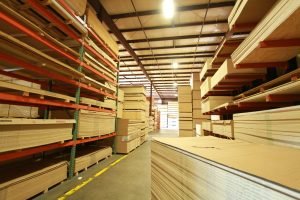Lamination is the process of permanently bonding many sheets together with the help of a hard press and adhesive. Plywood that is aesthetically enhanced by the addition of decorative laminate is called laminated plywood. Plywood is prepared by snowing wood together and then gluing them together using a lamination process. Decorative laminates (also called laminates) are placed over plywood to create a protective and elegant decorative surface. Timber slices (also known as veneer used to make laminated plywood) are obtained from logs and manufactured using a rotary cutting process. Each individual layer of wood is called a plywood. The layers must be bonded using strong adhesives such as urea formaldehyde and phenol formaldehyde before laminating the layers through a hot press.
Defects that are prone to occur in laminates and their solutions
- The reasons for the warpage of the laminated plywood panels are mainly due to the thermal stress caused by the temperature difference of each part of the heating plate during the hot pressing process and the uneven glue content of the adhesive tape. The cooling speed is too fast, the ejection temperature is high, and the internal stress of the glass cloth itself etc., and cause the sheet to warp.
- The surface of the laminate is flowered, and there are generally two cases: one is that there are white spots on the surface; the other is that there are pockmarks on the surface. Surface blooms tend to appear in thin sheets. (1) Causes of vitiligo: ①The glue content of the glass cloth is low; ②The adhesive cloth is too tender, and the resin on the adhesive cloth flows off a lot during pressing, forming vitiligo. Solution: ① The glue content and soluble resin content of the glass cloth should be within the specified range; ② The initial pressure of pressing should not be too high to prevent resin loss and white spots. (2) Pocked holes Causes of pockmarked holes: ①The adhesive tape is too old and the resin fluidity is poor; ②The pressure is too small or the pressure is uneven during pressing; ③The preheating stage of pressing takes a long time and the pressure is not timely. Solution: ①Choose the surface tape with high glue content and slightly high soluble resin content; ②Increase the molding pressure, increase the number of lining paper, and replace it frequently; ③The preheating stage should not be too long, and the pressure should be timely.
- The core of the plywood laminate sheet is black and the surrounding is white, the cause: the soluble content and volatile content of the adhesive tape are too large. During the preheating stage, the volatiles around the sheet are easy to escape, and there are more residues in the middle, showing that the core of the laminated ply sheet is black and the surrounding is white. Solution: reduce the soluble resin content and volatile content of the tape, and prevent the tape from getting wet.
The materials used are different. The material selected for the laminated plywood is wood veneer with a higher density that is impregnated with phenolic and then pressed together. The wood veneer used for plywood is more optional as long as it can be combined together. 2. The processing process is different. During the processing of the laminate, the veneer must be dried and impregnated to maximize the density. The moisture content of the veneer used for the plywood should not exceed the standard. 3. The flatness is different. The laminate will eventually achieve a rock-solid effect. Because of its hardness, the flatness is required to be very high. The warpage of the plywood sheet is very common, and it is generally reprocessed by post-finishing.
Laminate is a whole by superimposing and thermocompression bonding of two or more layers of resin-impregnated fibers or fabrics. Laminate is one type of laminate products. Plywood is a three-layer or multi-layer board material made of wood segments that are cut into veneers or sliced into veneers, and then glued together with adhesives. The fiber directions are glued perpendicular to each other.


